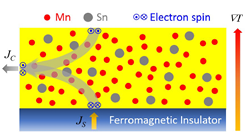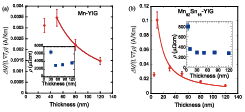Large Spin Hall Effect in Amorphous Mn-Sn Alloy Thin Film
Nakatsuji Group
Pure spin current contains only angular momentum without net charge flow, which greatly reduces the Joule heating. This feature makes spin current beneficial for low power spintronic devices. The spin Hall effect (SHE) converts charge current to transverse spin current, serving as an effective way to generate pure spin current. Meanwhile, as the reciprocal effect of the SHE, the inverse spin Hall effect (ISHE) converts pure spin current to transverse charge current, and plays an important role in pure spin current detection and conversion.

Fig. 1. Schematic of thermal spin injection from a ferromagnetic insulator into an attached metal layer.

Fig. 2. Thickness dependent thermal voltage for (a) Mn and (b) Mn-Sn alloy thin films on YIG. Insets are thickness dependence of resistivity.
Although manipulation of pure spin current in heavy transition metals, ferromagnetic metals, and their alloys have been extensively explored in the past decade, antiferromagnets have become a new central stage due to its prominent advantages such as high frequency magnetic dynamics, negligible stray field, and perturbation insensitivity. Among these materials, the non-collinear Kagome lattice antiferromagnets Mn3 (X = Sn, Ge, Ga) stand out because of their large transverse electrical [1-4] and optical [5] responses to the external magnetic field as well as their negligible magnetic moment.
In our work, we used the thermally generated pure spin current from the spin Seebeck effect (SSE) in the ferrimagnetic insulator yttrium iron garnet (YIG) to study the inverse spin Hall effect in Mn and the Mn-Sn alloys (Fig. 1). A series of samples with different thicknesses are sputtering deposited onto YIG substrates. By measuring the ISHE voltage, we obtained a sizable spin Hall angle θSH of -0.23% (which measures the conversion efficiency between chargecurrent and spin current), and a long spin diffusion length λsd ≈ 11.5 nm for the single element material Mn, as shown in Fig. 2 (a). Most importantly, by doping Sn in Mn, we found that the θSH of the Mn-Sn alloy, even in its amorphous form, is increased by 20 times to -4.4%, while the resistivity (ρ) is reduced by about 10 times, as shown in Fig. 2 (b). Therefore, the energy consumption (~ρ/θ2SH) of the Mn-Sn alloy is reduced by 4000 times compared to Mn. A spin pumping measurement further corroborates the enhancement of the θSH in the Mn-Sn alloy. These results not only serve as essential references in studying the pure spin current phenomena in Mn-based alloys, but also offer a promising method for exploring future energy efficient spin Hall materials with high spin Hall angle but low resistivity and thus low energy consumptions [6].
References
- [1] S. Nakatsuji, N. Kiyohara, and T. Higo, Nature 527, 212 (2015).
- [2] M. Ikhlas, T. Tomita et al., Nat. Phys. 13, 1085 (2017).
- [3] N. Kiyohara, T. Tomita, and S. Nakatsuji, Phys. Rev. Appl. 5, 064009 (2016); A. K. Nayak et al., Sci. Adv. 2, e1501870 (2016).
- [4] Z. H. Liu et al., Sci. Rep. 7, 515 (2017).
- [5] T. Higo et al., Nat. Photon. 12, 73 (2018).
- [6] D. Qu, T. Higo, T. Nishikawa, K. Matsumoto, K. Kondou, P. K. Muduli, Y. Otani, and S. Nakatsuji, Phys. Rev. Mater. 2, 102001(R) (2018).
